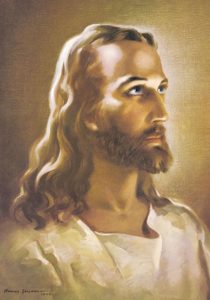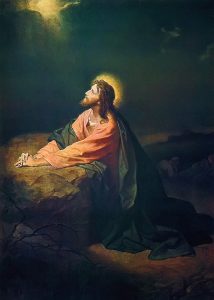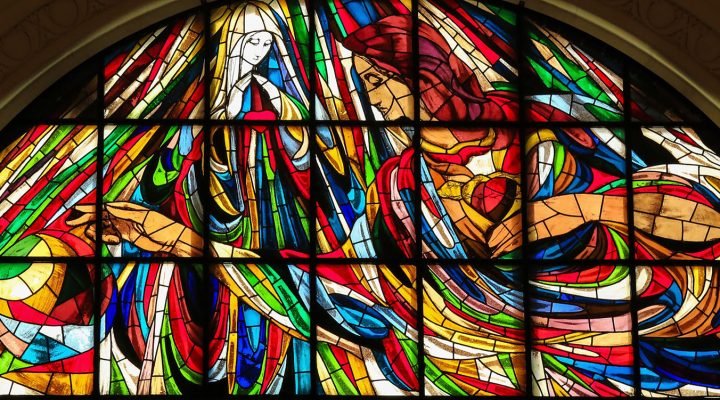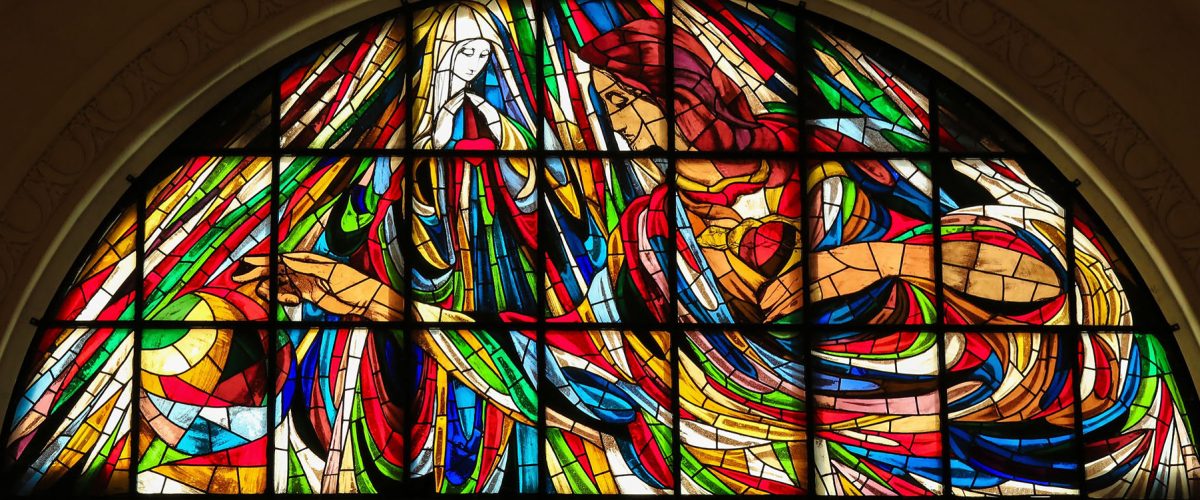A picture may be worth a thousand words, but occasionally a gasp is a more appropriate response.
Such was the case during an evening of sorting through old photos from the attic of my wife’s family home. Her father died four years ago after dementia’s long goodbye. This year, her stepmother moved to a retirement community, necessitating selling the house. Photos were among items my wife and her sister found. One of those photos elicited the gasp and accompanying confusion.
“Where was this picture taken?” I asked.

Tom Allen
“The living room of my Grandpa and Grandma Smith’s house,” Beverly responded.
“Are you sure?” I continued.
“Yep. The couch, the end tables, the lamps. That’s their den,” she said.
“Were your grandparents Catholic?” I asked.
“What? No. Baptists.”
Two framed prints on the wall of their den piqued my curiosity and questions. One depicted the Sacred Heart of Jesus; the other, the Immaculate Heart of Mary. Both images grace the homes of many Catholics, venerated and used in prayer and personal devotions. But the 1970s den of a Baptist family in rural north Georgia?
Those images, while graphic, kitschy and mistakenly European depictions, are also hauntingly beautiful.

Statue depicting the Sacred Heart of Jesus (123rf.com)
Jesus’ Sacred Heart is often depicted as an inflamed human heart, outside his chest. The heart is surmounted with a cross, surrounded by a crown of thorns and a bleeding wound. Typically, a very white, long-haired Jesus, with lovely eyes and a perfectly trimmed beard, extends one of his nail-pierced hands. The other hand points to his wounded heart. Devotion goes back to the 11th century, popularized by various mystics throughout the church’s history.

Statue depicting the Immaculate Heart of Mary (123rf.com)
Devotion to the Immaculate Heart of Mary, the mother of Jesus, began in the Middle Ages. Like the Sacred Heart of her son, Mary’s heart also is traditionally depicted as surmounted by a cross and flames, with rays of light emanating from the center of her chest. Her heart is imaged as pierced by a sword, recalling Simeon’s temple prophecy in Luke’s Gospel, when Mary and Joseph dedicated their infant son. Unlike Jesus’ heart, Mary’s is surrounded not by thorns but roses. Frequently, the doe-eyed, lily white virgin gazes at the faithful as she points to her immaculate but wounded heart.
Historically, Baptists, along with others in the free church tradition, reacted against the use of “images” in worship or private devotion. They affirmed Martin Luther’s belief that the Roman Catholic Church of his day was in need of reform, but they argued that Lutherans and later Anglican Reformers, had not gone far enough. For them, too much was still too “Roman.” No surprise those early Radical Reformers ditched stained glass, candlesticks and organs for plain, stark houses of worship. And there were certainly no crucifixes or statues, much less a painted image of Jesus.

“Head of Christ,” Sallman
Centuries later, Baptist worship spaces began to reveal the tradition’s evolving appreciation for beauty, color and transcendence. Although statues of Jesus or Mary might not be found in the vestibule, many a Sunday school class, church parlor or fellowship hall displayed framed prints of Warner Sallman’s iconic paintings — Head of Christ, Christ at Heart’s Door, and The Good Shepherd. And you didn’t suggest moving or changing out those pictures. In other words, you don’t mess with Jesus.
A photo from the 1950s I came across when cleaning out my parents’ house after their deaths reminded me that Jesus occupied a prominent place in our den as well. Two popular prints, Jesus in the Temple, and Christ in Gethsemane, both mass-produced over the past century, from paintings by Heinrich Hofmann, brought Jesus to life, both as a 12-year-old boy and the agonizing Son of God on the eve of his death.

“Christ in Gethsemane,” Heinrich Hofmann
Like those depictions of the Sacred Heart, Jesus was as white as my English ancestors. Yet those images, although erroneously Caucasian and Westernized, along with Warner Sallman’s art, helped many, including myself, grasp a Jesus who was as real as my relatives whose photos hung next to the 12-year-old boy in the Temple.
Neither my wife nor anyone in her family has any idea how those two pictures came to hang in her grandparents’ home. Perhaps they were a gift, or passed down from another relative, or simply purchased because, as persons of deep faith, Jesus was at the center of their home.
Mary’s immaculate heart on the wall is more puzzling. When I shared the story with a Catholic friend, his response was, “A mother who loved her son, and a son who loved his mother. What’s unusual about that?”
I chuckled, reminding him of how Baptists, although they defend the virginal conception of Jesus as strongly as the pope, make only slight mention of Mary in sermons or songs, usually, at some point during the Advent to Epiphany cycle or Holy Week, when we find her at the foot of the Cross. The more liturgical among us may sing settings of her “Magnificat”; a few may even sing her joyous words in Latin. Yet, although she holds a prominent position in our nativity scenes, she goes back into storage when the tree comes down.
But the question remains: How, and why, were those iconic pictures from a tradition both foreign to and, sadly, shunned by many a Protestant in that day, in the den of a rural, north Georgia Baptist family?
A shared loss may offer some clue. Children aren’t supposed to die before their parents, but my wife’s grandparents knew that deep sadness. A son was killed in a car accident, leaving a wife and two young children. Later, a grandson would take his life after returning home from the front lines in Vietnam, and my wife’s mother would precede her own mother in death. So perhaps those grandparents identified with a wounded Christ as well as his grieving mother.
“Perhaps, like Jesus, they knew what it felt like to have their hearts lanced and broken.”
Perhaps, like Jesus, they knew what it felt like to have their hearts lanced and broken. Like Mary, maybe they understood what it felt like to have their hearts pierced. Perhaps those pictures became visible reminders of a faith that had learned to embrace both joy and sadness, beauty and tragedy, life and death.
Surely the history behind how we have imaged Jesus and other biblical characters throughout Christian history is biased and complicated. Consider Da Vinci’s Last Supper. Like the Good Shepherd and Head of Christ, along with print reproductions, the images can be found on everything from tapestries to night lights. To rise above and challenge such legendary depictions of Jesus and Mary as light skinned and blue-eyed, instead of the Middle Eastern Jews they were, is both right and just.
And in rising above such stereotypes, perhaps we can see Mary as the one who not only said “yes,” but who carried the Son of God in her womb, beneath her own heart, so that his heart might one day beat with a love for all of us, a sacred love my wife’s grandparents were sure would never, ever end.
Tom Allen recently retired as minister of education at First Baptist Church, Southern Pines, N.C.
Related articles:
Study asks how art influences faith
Do the arts in church still matter? | Opinion by Doug Haney


